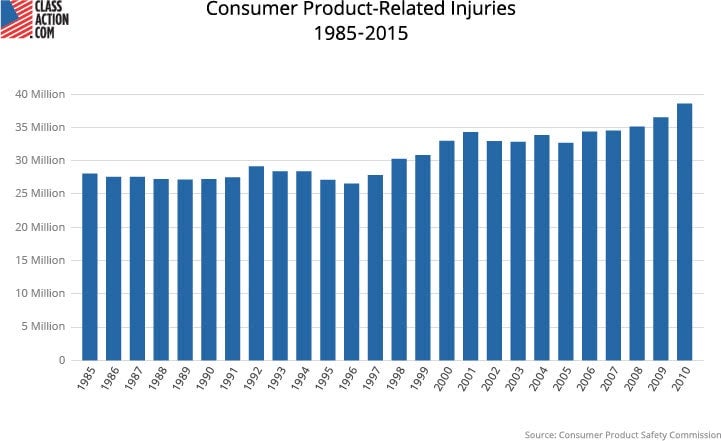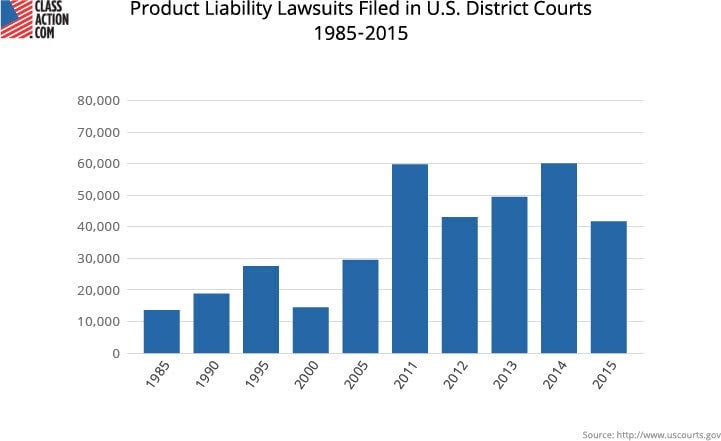(Updated Nov. 21, 2017)
Laws have evolved over the years to better protect those harmed by defective products. While several different legal theories underlie product liability claims, they are all based on the general principle that products should meet the ordinary expectations of consumers. This includes the expectation that products work as they are intended, are not unreasonably dangerous, and don’t have unknown risks. Product liability lawsuits are filed against the designers, producers, and sellers of defective products that cause injuries.
Product liability law targets the designers, manufacturers, and sellers of products that injure consumers.
If someone is injured by a defective product, they may be able to file a lawsuit against the company (or companies) in the distribution chain and recover damages. Product liability lawsuits are typically complex affairs and should be undertaken with help from an expert attorney.
If you or a loved one were injured by a defective or poorly designed product, contact us for a free, no-obligation legal consultation.
A Brief History of Product Liability Law
Until the early 20th century, product buyers had a difficult time suing manufacturers for product-related injuries. Two legal principles blocked consumers’ path to the courtroom door: the privity doctrine and negligence.
Courts began enforcing product warranties in the late 1800s, which allowed plaintiff recoveries against manufacturers of defective products. But under the privity doctrine, in order for a buyer to have a legal claim, they must have transacted directly with a manufacturer.
As manufacturers began relying more heavily on retailers for sales, users increasingly did not purchase products directly from manufacturers. As a result, manufacturers who sold defective products to a retailer who in turn sold the product to a plaintiff were insulated from liability.
Exceptions to the privity doctrine were made for defects a manufacturer fraudulently concealed from a buyer, as well as for products deemed “inherently” or “imminently” dangerous, such as firearms, explosives, and drugs.

Macpherson v. Buick Motor Co.—a seminal 1916 case brought when a wooden wheel on an early Buick spontaneously broke and injured the driver—effectively eliminated the privity requirement in defective product cases.
In Macpherson, Buick did not make the wheel, but could have discovered it through a reasonable inspection. The Court ruled that since the wheel’s likelihood to cause injury was readily discoverable, Buick was negligent and therefore liable.
The concept that a manufacturer should be subject to liability if its product is foreseeably dangerous —regardless of product type and privity—became a fundamental principle of modern product liability.
A defect is proof of negligence, no matter its cause.
Still, proving defendant negligence remained a significant hurdle. With the manufacturing process growing more complex, identifying a defect’s precise cause was difficult, if not impossible (for example, how could a plaintiff prove how contaminants ended up in food?).
Courts recognized this reality and began applying lower proof burdens. This led to the concept of “strict liability,” which says that a defect is proof of negligence, no matter its cause.
First applied to food and beverages, strict liability was adopted in the 1960s for all product types and for every foreseeable product user, laying the groundwork for modern product liability law and starting a surge in consumer lawsuits.
Which Products Are Subject to Liability Lawsuits?
Virtually any defective product sold on the market can be subject to a product liability lawsuit. The most common product categories include:
- Drugs
- Medical Devices
- Consumer Products
- Automobiles
- Toxic Chemicals
- Food
- Tobacco
- Machinery and Tools
What Types of Defects Lead to Product Liability Lawsuits?
In product liability law, three major defect types are recognized:
- Design defects: Some products are inherently faulty based on their design. Even when manufactured properly and used as intended, defectively designed products are configured in such a way that makes them unsafe. A design defect is typically found in an entire product line made to the same specifications.
- Manufacturing defects: A product that does not turn out as the manufacturer planned contains a manufacturing defect. The defect can result from improper assembly, physical flaws, or substandard materials. It could affect one or a small number of products different from others in the same product line, or it could affect the entire line.
- Marketing defects: Products can be dangerous by virtue of their labeling—or lack thereof. Manufacturers must provide instructions, labels, and warnings aimed at mitigating foreseeable harm. Labeling inadequacies can make products unsafe and may constitute a marketing defect.

Which Agencies Regulate Product Safety?
As the consumer product market grew and product liability litigation surged, safety agencies were legislated.
Various government agencies have jurisdiction over many types of consumer products. They possess statutory authority to set product standards and protect the public from unreasonable risks of product-related deaths, injuries, and property damage. They may make product rules (including design and safety requirements), monitor products in the field, ban products, issue recalls, and enforce penalties.
The following agencies are among those responsible for U.S. product regulation:
- Consumer Product Safety Commission (consumer products)
- Federal Aviation Administration (aircraft)
- Food and Drug Administration (drugs, medical devices, cosmetics, foods, veterinary medicines, and tobacco products)
- National Highway Traffic Safety Administration (automobiles, trucks, motorcycles, tires, and car seats)
- Environmental Protection Agency (pesticides, fungicides, insecticides, hazardous waste, air pollutants, asbestos, nuclear waste, toxic substances, and more).
- Occupational Safety & Health Administration (industrial, commercial, and farm products)
- Securities and Exchange Commission (financial products)
Private consumer advocacy groups—such as ClassAction.com—which predate government consumer agencies, also play a crucial role in fostering marketplace safety improvement.
What Should I Do If I Was Injured by a Product?
Government agencies operate on limited budgets and are responsible for regulating powerful companies that have vastly greater financial resources. Despite regulators’ best efforts, dangerous products still make it onto the market and into the hands of consumers, where they cause personal injuries and property damage.
Product liability lawsuits not only compensate the victims of dangerous products—they also hold wrongdoers accountable and promote greater safety compliance.
If you were injured by a product, fault may lie with the manufacturer or another company. Contact us today to learn your rights and hold the responsible party accountable.



